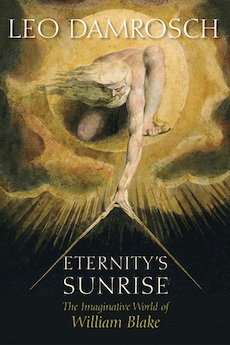Shortlisted for the 2016 ΦBK Christian Gauss Award
By Indira Ganesan
He who binds to himself a joy
Does the winged life destroy
But he who kisses the joy as it flies
Lives in Eternity’s sunrise
—William Blake, “Eternity”
With this small unpublished poem by William Blake, Leo Damrosch (ΦBK, Yale University, 1962) offers us the poet’s notion of happiness and the dilemma of art and life; that is the constant struggle between “a fuller and deeper engagement of reality,” without “self-centered possessiveness.” Kissing joy in flight is one way to describe this deeply sensual, brilliant, mad poet, a hero of the beats and sixties rockers, a man who captured the interest of Coleridge, though his works never found fame in his own time.
Eternity’s Sunrise is both a look at Blake’s life and an appreciation of the poet, painter, and thinker. It is in fact an invitation to celebrate the vision and cerebral potency of a man who was far ahead of his time, “a counterculture prophet,” as Damrosch puts it, “whose art still challenges to think afresh about almost every aspect of experience.” Damrosch leads the general reader through Blake’s world, using his prints, paintings, and poems to examine the genius of his imagination, while not shirking the psychological troubles that manifested from an early age.
Born in 1757, in London, Blake reported to his parents that he had seen angels, and “barely escaped a thrashing for telling a lie.” His parents did set him up in a school for commercial artists, followed by an apprenticeship at thirteen to an engraver. We see here not only his growing skill, but also his ingenious yet honest appreciation of his own prodigious talent. He began to illustrate books, illustrating the text with figures, an idea he would carry over into his own poetry. From engraving, he went onto to etchings, using a method in which he drew his design directly onto the copper plate, “allowing him to combine words and images in a single design.” This involved writing the text backward (which some New Age and nineteenth century mystics claim unlocks the creative side of the brain.) When Blake married, famously on the rebound, he found a life-long partner who not only assisted him in his work, but could rise to his spiritual and poetic preoccupations with humor; “I have very little of Mr. Blake’s company,” she is remembered once saying, “he is always in Paradise.”
Damrosch goes back and forth between the illustrations and plates in the book, and his own textual analysis of the poems. What we receive as readers is more than literary scholarship. Damrosch excavates the poems as the art they are, studying and analyzing color, figure, and composition with an art historian’s eye. We see not just the often anthologized “The Tyger,” but see two versions of Blake’s painted tigers, who turn out to be rather docile, and at odds with fierceness ascribed to the creature. The words don’t waver. The sheer force of Blake’s poem, the rapid beat of lines like “what dread hand? and what dread feet/ What the hammer? what the chain? /In what furnace was thy brain?” concluding with “Tyger, Tyger, burning bright/in the forests of the night;/What Immortal hand or eye, /Dare frame thy fearful symmetry?” continues to astonish.
This is not a book to hurry through. Blake’s poetry demands a careful study, simple at times, and overly mysterious at other times. I found myself reading, and going back to re-read, skipping ahead, only to return. I found myself struck by the illustrations, and trying to read in miniscule script the reproduced poems. I also found myself remembering some early gems I had forgotten I knew, like “London” with “each charter’d street/ Near where the charter’d Thames does flow./ And mark in every face I meet/Marks of weakness, marks of woe.”
The plates that form the centerpiece of the book, which as Damrosch admits, cannot do justice to the actual works (a friend who saw an installation of Blake years ago in New York said the colors were shimmering off the page), nevertheless are breathtaking. I wanted to read this book to learn more about Blake, to understand him in the context of his prints. By the end, I did, and heartily recommend the book to readers who not only want to learn more about Blake, but look at the work.
Novelist Indira Ganesan was inducted into Phi Beta Kappa at Vassar College in 1982. Her books include The Journey (Alfred A. Knopf, 1990), Inheritance (Alfred A. Knopf, 1998) and As Sweet As Honey (Alfred A. Knopf, 2013).




